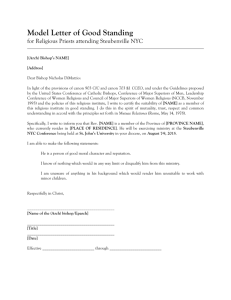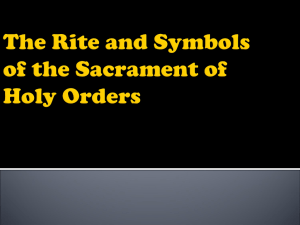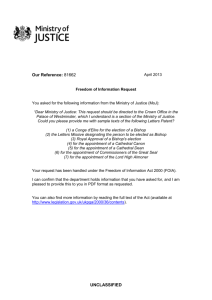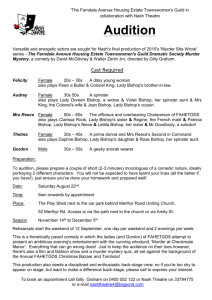The Bishop`s Residence
advertisement
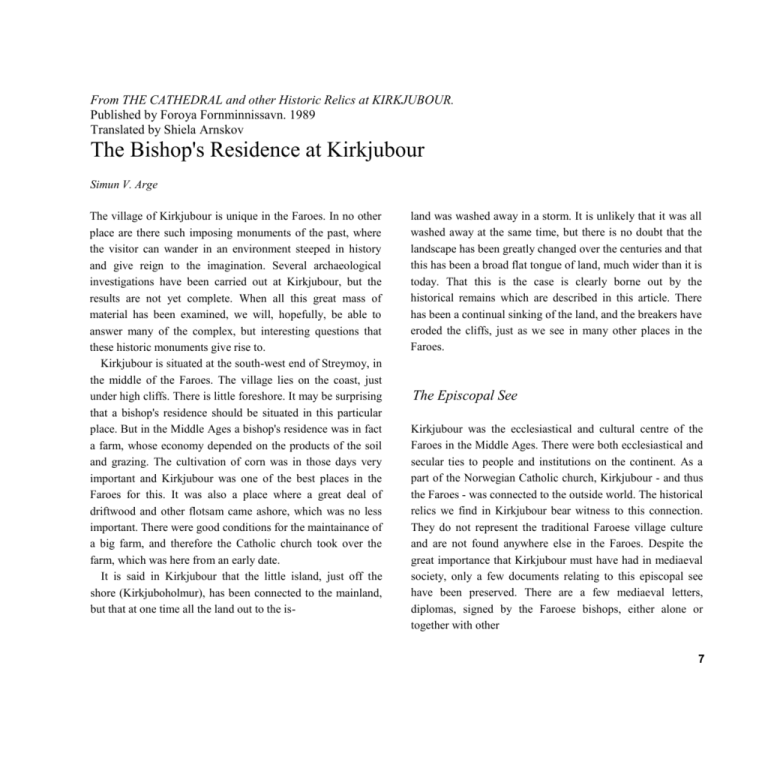
From THE CATHEDRAL and other Historic Relics at KIRKJUBOUR. Published by Foroya Fornminnissavn. 1989 Translated by Shiela Arnskov The Bishop's Residence at Kirkjubour Simun V. Arge The village of Kirkjubour is unique in the Faroes. In no other place are there such imposing monuments of the past, where the visitor can wander in an environment steeped in history and give reign to the imagination. Several archaeological investigations have been carried out at Kirkjubour, but the results are not yet complete. When all this great mass of material has been examined, we will, hopefully, be able to answer many of the complex, but interesting questions that these historic monuments give rise to. Kirkjubour is situated at the south-west end of Streymoy, in the middle of the Faroes. The village lies on the coast, just under high cliffs. There is little foreshore. It may be surprising that a bishop's residence should be situated in this particular place. But in the Middle Ages a bishop's residence was in fact a farm, whose economy depended on the products of the soil and grazing. The cultivation of corn was in those days very important and Kirkjubour was one of the best places in the Faroes for this. It was also a place where a great deal of driftwood and other flotsam came ashore, which was no less important. There were good conditions for the maintainance of a big farm, and therefore the Catholic church took over the farm, which was here from an early date. It is said in Kirkjubour that the little island, just off the shore (Kirkjuboholmur), has been connected to the mainland, but that at one time all the land out to the is- land was washed away in a storm. It is unlikely that it was all washed away at the same time, but there is no doubt that the landscape has been greatly changed over the centuries and that this has been a broad flat tongue of land, much wider than it is today. That this is the case is clearly borne out by the historical remains which are described in this article. There has been a continual sinking of the land, and the breakers have eroded the cliffs, just as we see in many other places in the Faroes. The Episcopal See Kirkjubour was the ecclesiastical and cultural centre of the Faroes in the Middle Ages. There were both ecclesiastical and secular ties to people and institutions on the continent. As a part of the Norwegian Catholic church, Kirkjubour - and thus the Faroes - was connected to the outside world. The historical relics we find in Kirkjubour bear witness to this connection. They do not represent the traditional Faroese village culture and are not found anywhere else in the Faroes. Despite the great importance that Kirkjubour must have had in mediaeval society, only a few documents relating to this episcopal see have been preserved. There are a few mediaeval letters, diplomas, signed by the Faroese bishops, either alone or together with other 7 Rune stone from Kirkjuhour — 40 cm long 19 cm high, 10 cm thick. National Museum in Copenhagen. bishops at ecclesiastical conventions. Only one or two documents have been signed at Kirkjubour. The Faroese bishops are occasionally mentioned in Icelandic historical records, and Kirkjubour figures in Sverre's saga. There is said to have been a seminary here, but altogether there is very little direct information about the daily life of the bishop's palace - of the farming or building work. In addition to these written sources there is a rune stone, which was found in 1832 in the outer basement, which has formed part of the bishop's palace. Only a part of the inscription is decipherable: »... Vigu(l)fi unni roa...«, i.e. »Give Vigulv peace«. This rune stone is con- sidered to be a Christian gravestone from the 1000's. Some people believe it to be older. Steeped as it is in history, Kirkjubour has been fertile soil for legends and stories about people, buildings, ruins and relics. Besides these there are the stories that we are familiar with from other places, common folklore. Many of them tell of events that took place several hundred years ago. But what we base our knowledge of the bishopric at Kirkjubour on must mainly be the examination of the existing relics - buildings, ruins and remains hidden under the whole area. The preaching of Christianity and the building of churches It is generally believed that Christianity came to the Faroes about the year 1000. From the Icelandic Saga we know that the king, Olavur Trygvason, tried to persuade the important men of the islands of the «western ocean» e.g. the Faroes, who were visiting him in Trondheim, to be converted and baptized. They were then bidden to go home and preach Christianity in their own countries. The Faroe Saga (Faereyinga saga), which was written ca. 1200, tells of events connected with the coming of Chris10 tianity. Unfortunately we know far too little about this period in Faroese history to be able to discuss it in more detail. But if we look at what was happening in the countries round about the Faroes at the same time we get a picture of the development. As soon as the new faith had taken root, churches began to be built all over the country. Archaeological investigations in the Faroes indicate that the first churches were probably small wooden structures, modelled on the stave churches in Norway, from where the message of Christianity had come. Most likely it was prosperous farmers who built the first churches on their own farms. The Faroese Diocese When the new faith had been accepted, the papacy made some moves. The archbishop of Hamburg-Bremen, who at that time was the Pope's most northerly representative, set about organizing the Nordic countries and the island communities of the North Atlantic into a separate diocese. In the middle of the 11th century dioceses were established in Norway, Orkney and Iceland. At first the work was carried out by so-called «missionary bishops», who travelled around the islands bearing the Christian message. In 1104 the Nordic countries became an archbishopric with the archbishop's residence in Lund. It is not known when the Faroese diocese was created, but there are several indications that it may have been at the beginning of the 12th century. The oldest of the mediaeval letters in which we can see the signature of the bishop of the Faroes are from the middle of the 12th century. In 1152-53 Norway was established as a separate archbishopric with its centre in Nidaros, and the Norwegian tributary countries in the North Atlantic: Greenland, Iceland, Orkney, Shetland, the Hebrides, the Isle of Man, and the Faroes were placed under its jurisdiction. The Norwegian ecclesiastical province now consisted of 5 bishoprics in Norway itself and 6 in the tributary countries. A number of canons were usually attached to the bishoprics. They made up the chapter. One of the rights of the chapter was to select the new bishop, and often one of the canons was chosen. However, in the smaller bishoprics, such as that in the Faroes, there was no chapter. It was the custom for the chapter in Bergen to select the bishop for the Faroes, and therefore a number of the bishops in Kirkjubour had been canons in Bergen. From various written sources, particularly the collection of letters belonging to HenrikKalteisen, archbishop of Norway 1452-58, we have the names of 33 men, of whom we can say, more or less with certainty, that they were all bishops in Kirkjub0ur. We know when they were bishops and in most cases the dates of their deaths. The first two are considered to have been missionary bishops. One of the first bishops is mentioned in Sverre's saga. This says that a Norwegian woman, Gunhild, who was married to Uni, a comb-maker in Bergen, had a son who was called Sverre. When he was five years old Sverre was sent to the Faroes, where he grew up in the home of Bishop Roi, who was Uni's brother. Roi educated Sverre and he is said to have been ordained as a priest. When Sverre was 24 years old his mother told him that he was really the son of the Norwegian king, Sigurd Haraldsson. The following year Sverre went to Norway to win back what he considered his rights as a king's son and heir to the throne. In 1184, after a long struggle, he became king of Norway. Regarding Sverre's connection to Kirkjubo-ur, it must be said that when he was 5 years old - according to the historical records this was about 1156 - Roi had not become bishop of the Faroes. The Icelandic annals say that he was consecrated bishop in 1162. Nevertheless, Roi could have been a priest in Kirkjubour when Sverre came. There has been a lot of discussion amongst historians as to whether the story is authentic, not least of all as to whether Sverre actually was heir to the throne. In the Faroes there are many tales of Sverre, who became one of Norway's most powerful kings, and his connection to Kirkjub0ur. The most famous of the Faroese bishops is undoubtedly Erlendur, who was bishop from 1269 until his death in Bergen in 1308. He appears to have been very active and to have acquired a great deal of land for the church. In this he may well have acted somewhat harshly because in the latter years of his office there were several complaints about his behaviour made to the king of Norway. Coin bearing King Sverre's portrait. Probably he played a political role as advisor to the king in Faroese matters. In this connection he was involved in making the «Sheep Letter» (Seydabnevid - the name given to an enactment of 24th June, 1298 concerning sheep-farming etc. in the Faroes). He appears to have taken part in many important conferences in Norway. In Kalteisen's previously mentioned collection of letters there is a letter which one of Erlendur's successors, Bishop Joan (Johannes Teutonicus) wrote in 1420. Joan was bishop from 1408 to about 1430 and is the author of most of the letters in the collection concerning the Faroes. This particular letter tells that a lead plaque with a runic inscription had been found in Erlendur's grave. 13 Amongst other things the inscription says that Erlendur was the first to build stone buildings in the bishop's palace. Besides this he laid the foundation of a stone-built cathedral. Since this collection of letters was found at the end of the 19th century in a library in the German town of Koblenz, it has been regarded as quite certain that the cathedral which is mentioned is the one in Kirkjubour. Erlendur was so highly regarded that Bishop Joan endeavoured to have him made a Faroese saint. This, however, came to nothing. It was customary for a bishop to be buried in his own cathedral. Despite the fact that we know the names of 30 bishops, it is surprising that we actually only know of one bishop's grave in Kirkjubour. This one could be proved to be a bishop's grave by the fact that the person buried there had the bishop's crosier beside him. In addition to this there is a headstone in which the words Eps Joan - Bishop Joan - can be deciphered from the inscription, which is almost illegible. This headstone, which there is every reason to believe is from the 15th century, indicates one more bishop's grave. One can ask, where then are all the other bishop's buried? It is unlikely that all those who were appointed ever actually came to the Faroes - tenants may have worked the farm. However, this is a matter of which we as yet know little or nothing. In accordance with the general trend in the 16th century, it was the king - not the pope, as had previously been the case who ratified the election of the last Catholic bishop in the Faroes in 1532, Amundur Olavs-son. He had also been a canon in Bergen. We do not know for certain when the Reformation became official in the Faroes. At some time between 1538 and 1540 Amundur Olavsson was deposed, and at the same time the Catholic priests who would not accept the new doctrines were also dismissed. With the appointment of Amundur Olavsson's successor, the Danish Jens 14 Figure of a bishop on a prayer stool from the parish church at Kirkjubour. The bishop's crosier found in a grave under the choir of the parish church at Kirkjub0ur. Gregerson Riber, as Lutheran bishop - or superintendent - in the Faroes 1st January, 1540, we can assume that the Reformation was finally officially approved in this country. It is said of Riber that he could not stay in the Faroes because of pirates, and in the end he fled the country. In 1557 he was appointed bishop in Stavanger in the same year the bishopric in the Faroes was abolished and the Faroes became a deanery under the bishop of Bergen, later the bishop of Zealand and Copenhagen. The bishops had done well for their church. When the bishopric was abolished, the church owned half of all the land in the Faroes. The king took over all this wealth for the crown, the seminary was done away with, and the language of the church, which had been Latin, became not Faroese, but Danish. The importance of Kirkjubour as the ecclesiastical and cultural centre of the Faroes was at an end. 15 The bishop's palace - the timbered rooms This house has been the home of the farmers in Kirkjubour for centuries and still is. The timbered rooms and, what is known in Faroese as the «roykstova» (royk=smoke, stova=room), the living room in which the fire was, stand on a wide stone basement, which is completely different in shape from the house. It is clear that this basement was not made for this house - it is part of the old bishop's palace, which no longer exists. Archaeological investigations in the 1950's revealed so many relics from the bishop's palace that it was possible to get a picture of what it was like. The main part of the palace was two parallel buildings with a beautiful 16 m broad paved courtyard between them. The courtyard was enclosed by stone walls on the north and south, and a brook ran close past the west building. The east building, which nowadays is the basement of the farmer's house, has undoubtedly been the ground floor of the house in which the bishop lived. The building is about 11 metres wide, and 25 metres of the length are preserved. The walls, which are 1.65 m thick, are constructed in the same way as those of the church. They are so thick that the upper storey may well also have been built of stone. There are small window openings in the east and south walls. The portals, which open on to the 17 courtyard, have been restored at a later date. At some time in the Middle Ages the east building has been severely damaged by an avalanche. It may have been after this that the bishop had two more rooms added to the east wall and between them a staircase. Here, there was an entrance facing the new cathedral. The west building was 45 m long and 7 m wide on the outside. In the part that has been investigated 4 rooms are revealed, 3 of them with doors out to the courtyard. It is possible that a storey built of wood has stood on the meterthick walls. The timbered rooms and the «roykstova», which are part of the more modern farm house, are log buildings and not stavebuilt, as was the custom in the Faroes. It is difficult to say when this house was built on top of the basement of the bishop's palace, and how old it is, other than that it is mediaeval. It may have been brought here from some other place. In Kirkjubour it is said that these log buildings came ready-made from Norway. They have been reconditioned later, but the «roykstova», which is in the farm house, is more or less in its original form. Because the «roykstova» does not exactly fit the basement walls there are supports set in under the joists. One of them is an octagonal pillar with a beautiful capital carved in Gothic style. The existing timbered rooms are only part of a much larger timber building, which was at one time 15 m long and 8.5 m wide. The part which is missing - it was demolished at some time in the last century - was a big hall - 10.5x5 m and open up to the rafters. The foundation can still be seen to the north of the existing timbered rooms, which have formed the entrance hall, from which there was a passage into the main hall. This sort of construction was built in big farms in Norway about the year 1300. Door in the basement of the east building. 19
